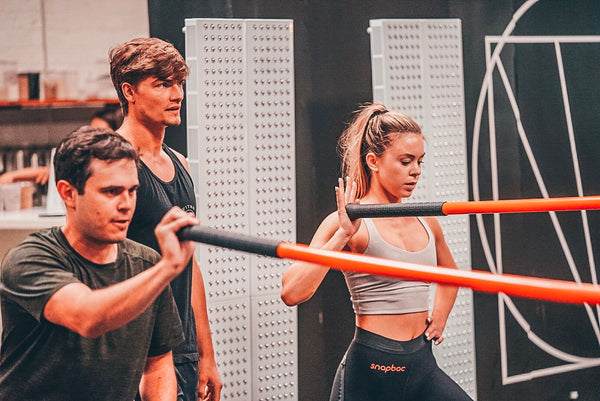Introduction
American football may be a team sport, but that doesn’t mean you are limited to team practices and trainings, thanks to at-home football drills for speed and strength. If that were the case, it would be impossible to train as much as you need to in order to become one of the best on the field. Most of you started by tossing a ball in the back yard with a friend or family member. If you took to the sport, you played through high school and eventually went out for the college team. It’s at this moment when you make the decision to dedicate your life and body to the sport or move on. If you chose to be a pro, then you chose a life dedicated to training with the team, at home, and on the road. After college, you hopefully signed with an agent and headed to a training facility. It is there that you dive into daily practice for the biggest moment of your life: the NFL Scouting Combine. The next one begins on February 26. Are you ready?
Why Training with Football Drills Outside of Practice is Essential
To be one of the best on the field, you must train like the best off the field. This means doing a whole lot more than team practice and your morning gym hour. You may be thinking that football is a team sport and training requires a team, but that is absolutely wrong. You certainly need your team scrimmages, but it is the work you do on your own - perfecting your form, building your strength, honing your speed and agility, and preparing your mind - that will take you from college athlete to professional player.
Another misconception is the need for a gym. Your best training ground is an open field. And the best equipment will be cones, tape, a chair, and, of course, the football. When you set out to train like a pro, you must think like one. This means going through a game in your mind and analyzing the movements made by your body. Think of the power needed to push off the line into a sprint, the force to jump vertically and horizontally, the range of motion necessary in a Hail Mary pass, and the strength for a full body defensive tackle. Think through the endurance, stamina, mobility, strength, speed, explosive power, tight agility, and accuracy under pressure. These are the skills you must smash all on your own, and here’s how to do it!

How to Prepare for the NFL
If you want to be in the NFL, you need to train like the NFL. Sorry to say that a Monday through Friday 8 to 5 job could make that nearly impossible, but if you want to be the leading quarterback in your weekly office game, these tips will certainly give you the edge on your competition.
When training for the Combine, this is a standard schedule four days a week while the other three days are used not for couch surfing, but for active recovery training such as low impact training in water or on a mat.
-
8 – 9 am Get up, get ready and get fueled!
-
9:30 1st workout focuses on speed, power, agility and position specific training on the field
-
11:30 Grab some lunch and power up.
-
2 pm 2nd workout builds full body strength and trains form in the weight room
-
4 Now recovery with stretching, cool down, heat, ice and necessary treatments
-
5:30 Healthy dinner.
Are you ready to make this your life for a minimum of six weeks as you prepare to crush the Combine and then dedicate the next 3 to 6 years to this schedule and more? We thought you would say, ‘yes.’ That’s why we’ve found the ideal combination of football drills that you will need to catch the eye of the scout, get your invitation to the Combine and earn one of the 224 picks for the NFL draft. We paid particular attention to training for 7 of the 8 primary tests you will need to dominate: the 40-yard dash, vertical jump, 225 bench press, broad jump, 3-cone drill, and the 20 and 60-yard shuttle. As for the position specific tests, you will need to make sure your body and mind are ready to achieve your dreams!
6 American Football Drills You Can Do at Home
These six drills target the key skills needed to gain attention and points at the NFL Scouting Combine. If your interest is more casual, these skills will still be the primary training techniques needed to crush your high school, college or neighborhood game. If you want to play like the best, you need to train like the best!

1. The 40-Yard Dash
Can you beat Jon Ross’ 4.22 40-yard dash? If not, it’s time to train. This is about explosive power, form and technique. According to training experts, you need to be as close to that line as possible when you start, keep your upper body low, your head tucked and be sure to use your arms! Your legs will move faster if you your arms are moving, so be pumping your hands from your chin to your glutes with your elbows at a 90-degree angle.
There are many drills to help you with form, power and speed, but to choose one, we like the prowler sprint. Keep your hands around the middle so your body leans forward, push your toes to the front of your tennis shoes, lock your ankles and focus on power pushing up through your glutes. By building strength, you build power. Power increase your rate of force development by initiating contraction and ground impact, so focus on getting your knees up in front of your body and powering through the ankle the moment your foot hits the ground.
2. The 3-Cone Drill
Your success in a play is determined by your speed in both reaction and action, seeing the play and rapidly changing direction at an angle. The 3-cone drill is just one football drill focused on maintaining your speed while circular running or following an arc to get the best angle. This is relevant to most positions in football and will be crucial in your training, so we chose the arch run drill as your best training option. It can be hard on the body so keep practice to once a week with adequate rest between sets.
Set your cones 5-yards apart and start 3 yards from the first cone in a two-point stance, leading with your dominant leg and the opposite arm back with your palm near your hip, elbow up, head tucked, and your torso forward. The body follows the head and the legs follow the arms, so keep your head in towards the cones and your arms pumping. The first and second cone will be smooth but be sure to round towards the third cone out of the second stop and not square it.
3. The Vertical Jump
This is all about technique and power distribution. You must know the difference between being explosive or powerful. Your strength is often powerful, and you can do anything once, but you need to train for repetitive, explosive contractions. We have found no better training than the box jump. Don’t grab the 24-inch at the beginning, even if you can clear it. You need to work on perfect form and equal strength in both legs. Your leading leg is nearly always stronger than the other and this decelerates your running and jumping.
So grab the 12-inch box and get started with basic box jumps and one-leg jumps working on powering through the ankles, knees and thrusting your hips. Start with your feet hip-width apart, arms at a 90-degree angle. The key here is to not stop at the bottom of your squat! You want one full movement where you sink into a quarter squat triggering your calves, hamstrings and glutes to push up through the floor to launch yourself onto the box. The moment your feet contact the box, push off and back to the floor. When you’ve mastered your form, place the 24-inch box 2 – 3 feet in front of the 12-inch and work on jumping up, down and powering through a second jump.

4. 225 Bench Press
If you’re focusing on your strength, you may not pass this test. The 225-bench test is about endurance, high numbers of reps and perfect form. By increasing your strength, you will find 225 much easier to press, but how many unbroken reps can you complete?
Remember, it is your form that is being judged. You need to keep all of your points of contact, your head, shoulders, and butt stay flat on the bench, feet firmly on the floor and squeeze your shoulder blades together to bridge your torso minimizing the distance you move the bar. You must touch the bar all the way to your chest without bouncing it and extend upward with full lockout to be counted as one rep. Perfect form gives you efficiency of movement and minimizes your range of motion to conserve energy where needed.
When practicing, go as fast as you can with a spotter at all times. You have 20 – 30 seconds before muscle fatigue begins, so you want to get as many reps as possible from the beginning.
You obviously need to be strong as well and this strength needs to come from neck, chest, shoulders, biceps, and, for a clean lockout, your triceps. Use chain bench presses to increase strength and perfect your lockout.
5. The Broad Jump
Just as the vertical jump was about explosiveness, the broad jump is about power. This is your wide receiver and defensive cornerback. Your power comes from massive lower body strength and the ability to sink low and propel your body forward. You need to build your power from a motionless stance, with your feet forward on the line. This is the same technique with the box jumps above, getting your power to build with your squat. It is your form in the air, right before landing that will make all the difference. You need to throw your body into the movement with your feet and hands out in front of you.
As you’re already doing box jumps, we recommend strengthening your legs with a weighted, elevated reverse lunge. Grab a barbell with comfortable weight across the top of your shoulders and starting on a box step backward dropping the back knee below the front foot. Lock your ankle, touch your knee to the floor and then power back up through the hips.
6. The 20- and 60-Yard Shuttle
Once more, it is your technique that builds efficiency. You must be in a proper starting position, use lateral movement, change direction rapidly, and finish strong. The 3-cone drill and 40-yard dash training will both reinforce the shuttle. The 60-yard shuttle will also challenge your endurance.
So grab four cones and place them 10 yards apart. Start in your 3-point stance at the first cone. Sprint to the second cone, touch the ground and return to the first, then sprint to the third cone, touch the ground and back to the first and sprint to the last cone, touch the ground and sprint back past the first cone. Keep your hips low and your outside foot rooted next to the cone at the turns. Practice switching your direction at each turn and keep your form tight.
What Will You Do to Be the Best?
The best athletes know that training begins in the mind. With the heavy demands placed on professional NFL players, a lot of support is needed from their coaches, agents, sport psychologists, nutritionists, family, and friends. Your body is only half the equation. You must get your mind in the zone before every workout, practice, and game. This means letting everything else drop away - stress, social obligations, physical exhaustion - everything but the task at hand. Find what works for you, be it meditation, music, an energetic warm up, watching big game replays or a spiritual practice. You may feel anxious, terrified and even nauseous, but in the words of many coaches and athletes, your attitude and your effort are all you can control, so keep your focus there. Don’t forget to keep these essential athletic exercises in mind, as well as a cool down routine. And if football isn’t your speed, there are always soccer training drills.



